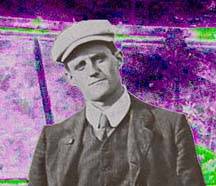This amateur guide to James Joyce is intended to do two things: First, to introduce this modernist master to the philistines out there who have either never read or never heard of him and second, to designate the work according to level of Joyce enthusiast you aspire to be. In other words, instead of doing these four books piecemeal, I’ve decided to lump them all together into four levels of increasing pain and frustration.
 Part One – The Beginner: Moderate to severe headache and nausea.
Part One – The Beginner: Moderate to severe headache and nausea.
If you should read only one book by James Joyce in your lifetime, read Ulysses. The book’s fractured timeline and experimental prose make it one of the most important examples of the modernist style and evidence of the beginning of the movement. Set in Dublin, Ulysses covers the events of a single day in the lives of its two main characters. Specifically, June 16th 1904.
Part I of the novel begins at 8 A.M. and follows Stephen Dedalus, who also appears in A Portrait of the Artist as a Young Man, for about three hours. Part II also begins at 8 A.M., but Leopold Bloom is its main character. He starts his day with breakfast and some alone time in the toilet before wandering around Dublin. Throughout the day, Leo and Stephen cross paths now and again but do not meet, not until Part III. This last section is written in stream of consciousness, except when someone speaks. It contains the longest sentence in English literature at 4,391 words. I use the word ‘sentence’ loosely, as there’s no punctuation involved.
I suggest reading a bit about Ulysses before attempting to read the book; it is utterly confusing. Joyce actually had to draw a chart for two of his friends to help them understand the book’s intricate structure. Its 732 pages can be subdivided into eighteen chapters, each employing a different writing style: stream of consciousness, journalistic, theatrical play format, and hallucinatory, among others. The eighteen chapters are also linked to a color, a part of the body, and an episode of Homer’s epic poem.
Entire careers have been devoted to the study of this book, so don’t worry if you can’t understand it. I’m sure if anyone living actually understood Joyce’s obscure narrative weaving and the minutiae of its structure, they’d be able to see the future and call things into being by thought alone. Of James Joyce’s work, Ulysses most thoroughly encompasses his writing style and perhaps his mental state. Give it a whirl.








